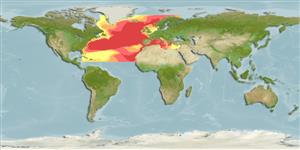>
Myctophiformes (Lanternfishes) >
Myctophidae (Lanternfishes) > Lampanyctinae
Etymology: Lampanyctus: Greek, lampas, -ados = torch + Greek, nykte = night (Ref. 45335).
More on author: Risso.
Environment: milieu / climate zone / depth range / distribution range
Écologie
marin bathypélagique; océanodrome (Ref. 51243); profondeur 0 - 1200 m (Ref. 56504), usually 275 - 1000 m (Ref. 117245). Deep-water; 72°N - 16°N, 82°W - 36°E
Eastern Atlantic: strays as far north as Dohrn Bank (off East Greenland) and off northwest Iceland, from British Isles to Mauritanian Upwelling Region including the Mediterranean (Ref. 4479). Western Atlantic: as shallow as 46 m in Ungava Bay, Canada, in slope water region (Ref. 5951).
Taille / Poids / Âge
Maturity: Lm ? range ? - ? cm
Max length : 30.0 cm SL mâle / non sexé; (Ref. 4479)
Rayons mous dorsaux (Total) : 13 - 14; Rayons mous anaux: 16 - 18. Distinguished from other species of Lampanyctus by the pattern of its photophores and by its short pectoral fins located just behind gill opening (Ref. 5571). Photophores along ventral post-anal region (AO): 6 (7) + 8 (7-9) = 14 (13-16) (Ref. 4775).
High-oceanic, between 700-1,000 m during the day (with juveniles in the upper 200 m) and 45-250 m and 4000-1,000 m at night (Ref. 4479). Depth range from 318-1192 m in the eastern Ionian Sea (Ref. 56504). Epipelagic to bathypelagic, feeds on zooplankton (Ref. 58426). Catches of lanternfishes off the west coast of South Africa: 1,134-42,560 mt (Ref. 5571). Minimum depth from Ref. 58018.
Life cycle and mating behavior
Maturité | Reproduction | Frai | Œufs | Fécondité | Larves
Apparently spawns in deepwater.
Bauchot, M.-L., 1987. Poissons osseux. p. 891-1421. In W. Fischer, M.L. Bauchot and M. Schneider (eds.) Fiches FAO d'identification pour les besoins de la pêche. (rev. 1). Méditerranée et mer Noire. Zone de pêche 37. Vol. II. Commission des Communautés Européennes and FAO, Rome. (Ref. 3397)
Statut dans la liste rouge de l'IUCN (Ref. 130435: Version 2024-1)
Menace pour l'homme
Harmless
Utilisations par l'homme
Pêcheries: d'intérêt potentiel
Outils
Articles particuliers
Télécharger en XML
Sources Internet
Estimates based on models
Preferred temperature (Ref.
123201): 3.4 - 14.6, mean 7.9 °C (based on 594 cells).
Phylogenetic diversity index (Ref.
82804): PD
50 = 0.5000 [Uniqueness, from 0.5 = low to 2.0 = high].
Bayesian length-weight: a=0.00417 (0.00327 - 0.00532), b=3.17 (3.11 - 3.23), in cm total length, based on LWR estimates for this species (Ref.
93245).
Niveau trophique (Ref.
69278): 3.2 ±0.39 se; based on food items.
Résilience (Ref.
120179): Faible, temps minimum de doublement de population : 4,5 à 14 années (Preliminary K or Fecundity.).
Fishing Vulnerability (Ref.
59153): Low to moderate vulnerability (27 of 100).
Nutrients (Ref.
124155): Calcium = 46.8 [13.0, 130.5] mg/100g; Iron = 0.409 [0.153, 1.286] mg/100g; Protein = 16.6 [14.8, 18.4] %; Omega3 = 0.258 [0.088, 0.738] g/100g; Selenium = 17.5 [5.5, 56.1] μg/100g; VitaminA = 53.6 [6.7, 453.7] μg/100g; Zinc = 0.651 [0.330, 1.380] mg/100g (wet weight);
